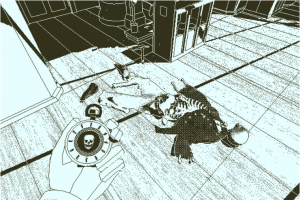
‘Return of the Obra Dinn’ game review
By Duncan Fingarson, Senior Columnist
Return of the Obra Dinn is one of the finest puzzle games I have ever played. If all you’re looking for is the recommendation, there it is.
The game is great and everyone who likes mysteries, deductive reasoning, or the Golden Age of Sail should try it. The question of why it’s so good, however, deserves further explanation. In the interest of preserving the experience, this review will remain spoiler-free.
Return of the Obra Dinn is the most recent game from the mind of Lucas Pope, whom you may recall as the person who brought us Papers, Please. This game has a similar low-resolution graphical style, based on the early computers that only had two colours for any given pixel so each pixel was one or the other. It’s an artistic style of stark contrasts, of light and dark, and it works quite well. The game also has a similar concept in that the protagonist has a perfectly ordinary profession (in this case, an insurance adjuster), which is used as a vehicle for an extraordinary story.
The game kicks off with the protagonist travelling by boat to the Obra Dinn, the merchant vessel of the titular return. Every member of the crew is presumed dead and only corpses are on board. The protagonist’s job is to find out what happened to everybody so that the East India Company can file an accurate insurance claim.
Here’s where things get a little strange: The player is armed with a magical pocket watch that can return them to a person’s moment of death. You get a brief sound bite, encompassing what that person heard in the last few seconds before they died, and are then given a freeze-frame, three-dimensional environment to wander around in. You also get a book that contains a crew manifest, a handful of sketches, and a short glossary of terms explaining such things as what, exactly, a midshipman does.
There’s very little hand-holding. You’re expected to work out everyone’s identities and fates based entirely on contextual clues from the scenes and dialogue. Most aren’t obvious, with the four Chinese topmen standing out as a particularly difficult challenge. You can’t just brute-force the answer by guessing, either; the game won’t tell you if you’re right or not until you’ve gotten three people entirely correct.
This challenge is what makes Return of the Obra Dinn so compelling. It makes the player feel clever in a way that few other games can manage. When you get something right, it’s because you figured it out—without any help from the game. Everything is there, to be sure, but you must put it together yourself, and usually doing that is just hard enough to avoid being frustrating.
There are a small number of things that could be improved. One particularly vital clue is very easy to miss if you don’t know what to look for. The book page for a given memory takes a short time to activate on your first visit to that memory, forcing the player to wait before they can look at it. These are minor things, though, and the game’s writing and attention to detail are more than adequate compensation. If there’s anything truly unfortunate about Return of the Obra Dinn, it’s that you can only play it for the first time once.


